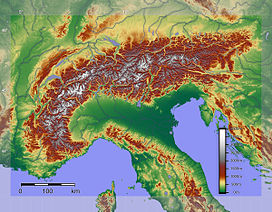European Alps
| Alps | |
|---|---|

Mont Blanc, the highest mountain in the Alps, view from the Savoy side
|
|
| Highest point | |
| Peak | Mont Blanc |
| Elevation | 4,808.73 m (15,776.7 ft) |
| Coordinates | 45°50′01″N 06°51′54″E / 45.83361°N 6.86500°E |
| Geography | |
|
Relief of the Alps. See also map with international borders marked
|
|
| Countries | |
| Range coordinates | 46°30′20″N 9°19′49″E / 46.5056°N 9.3303°ECoordinates: 46°30′20″N 9°19′49″E / 46.5056°N 9.3303°E |
| Geology | |
| Orogeny | Alpine orogeny |
| Age of rock | Tertiary |
| Type of rock | Bündner schist, flysch and molasse |
The Alps (/ælps/; French: Alpes [alp]; German: Alpen [ˈalpən]; Italian: Alpi [ˈalpi]; Romansh: Alps; Slovene: Alpe [ˈáːlpɛ]) are the highest and most extensive mountain range system that lies entirely in Europe, stretching approximately 1,200 kilometres (750 mi) across eight Alpine countries: Austria, France, Germany, Italy, Liechtenstein, Monaco, Slovenia, and Switzerland. The mountains were formed over tens of millions of years as the African and Eurasian tectonic plates collided. Extreme shortening caused by the event resulted in marine sedimentary rocks rising by thrusting and folding into high mountain peaks such as Mont Blanc and the Matterhorn. Mont Blanc spans the French–Italian border, and at 4,810 m (15,781 ft) is the highest mountain in the Alps. The Alpine region area contains about a hundred peaks higher than 4000 metres (just over 13,000 feet).
...
Wikipedia

